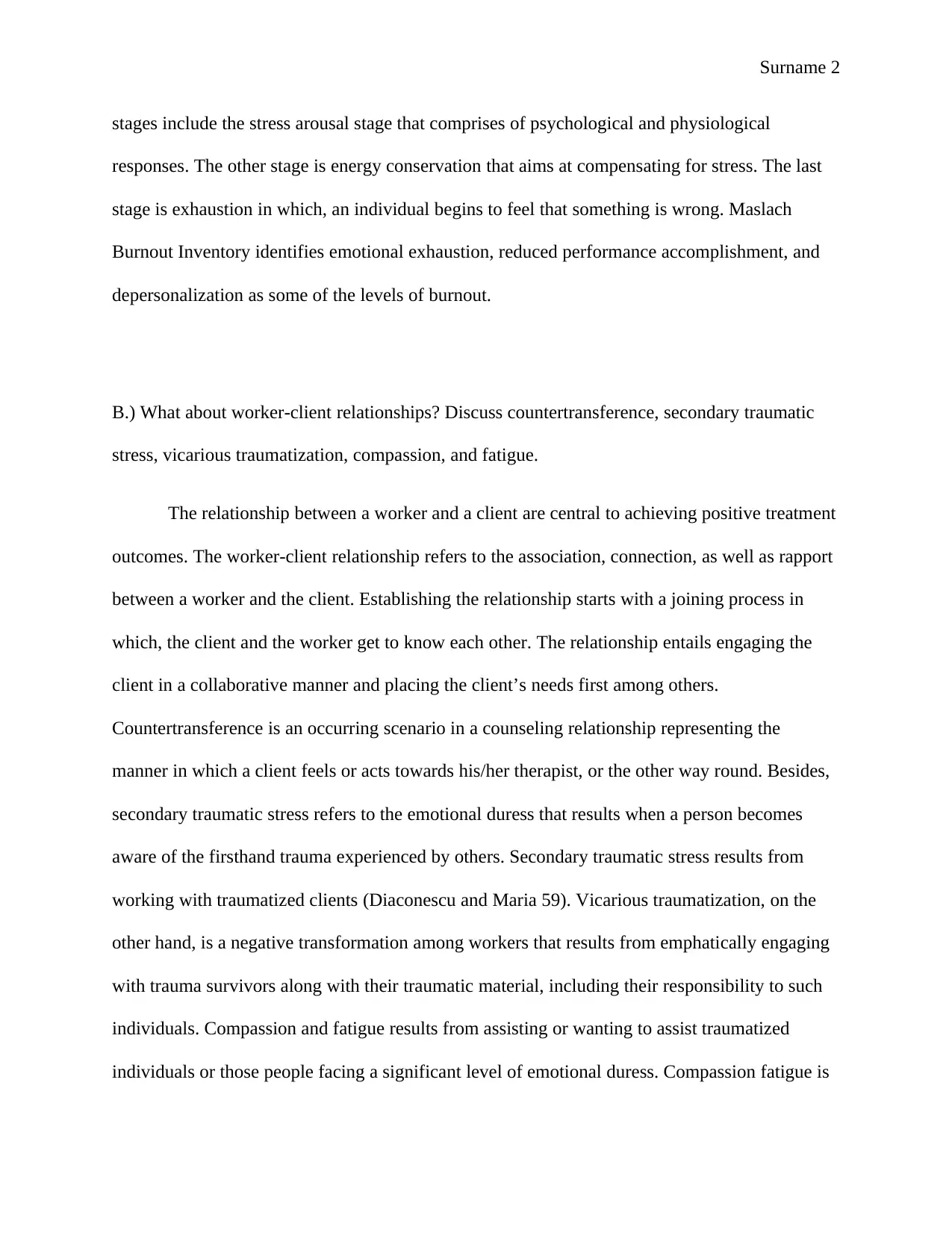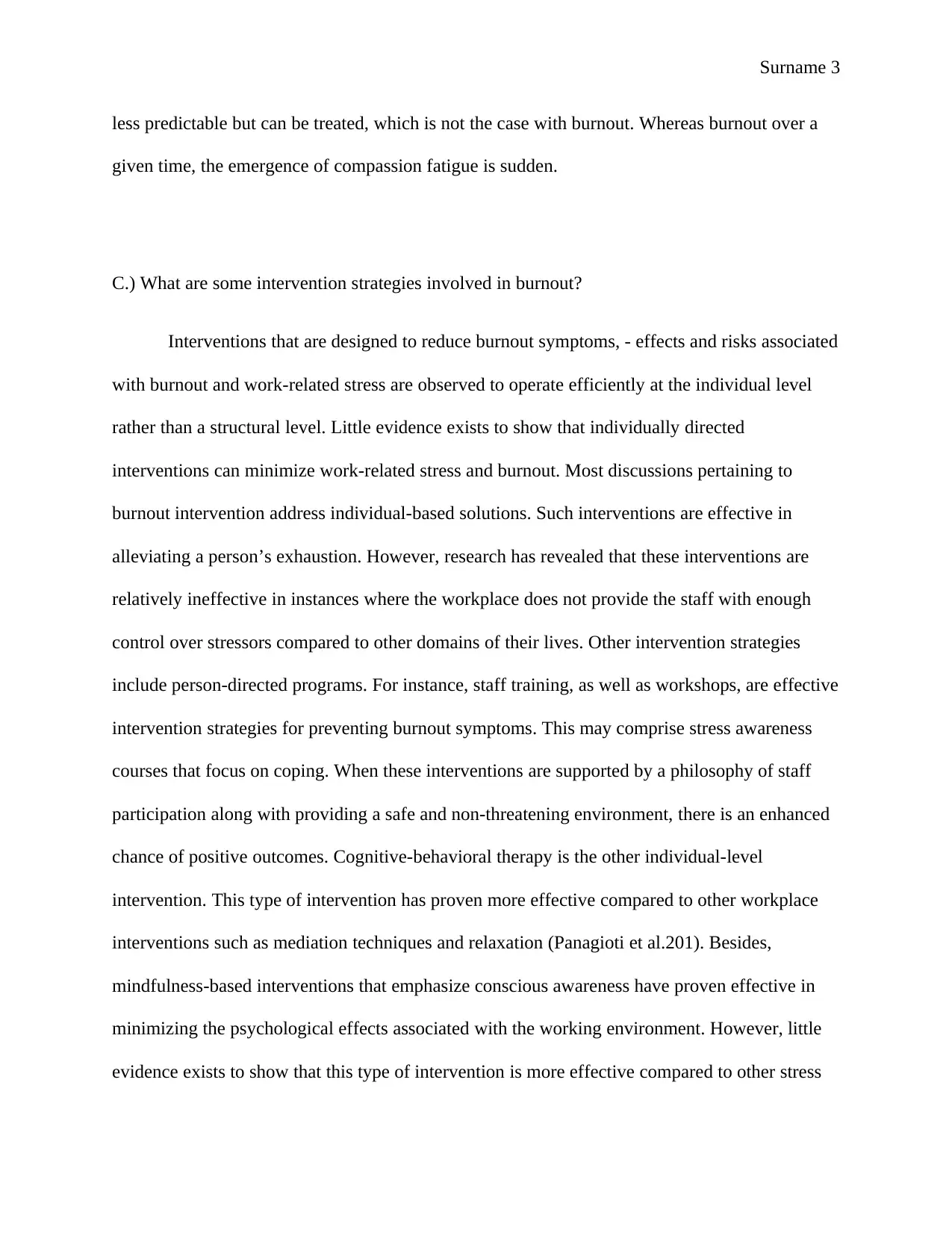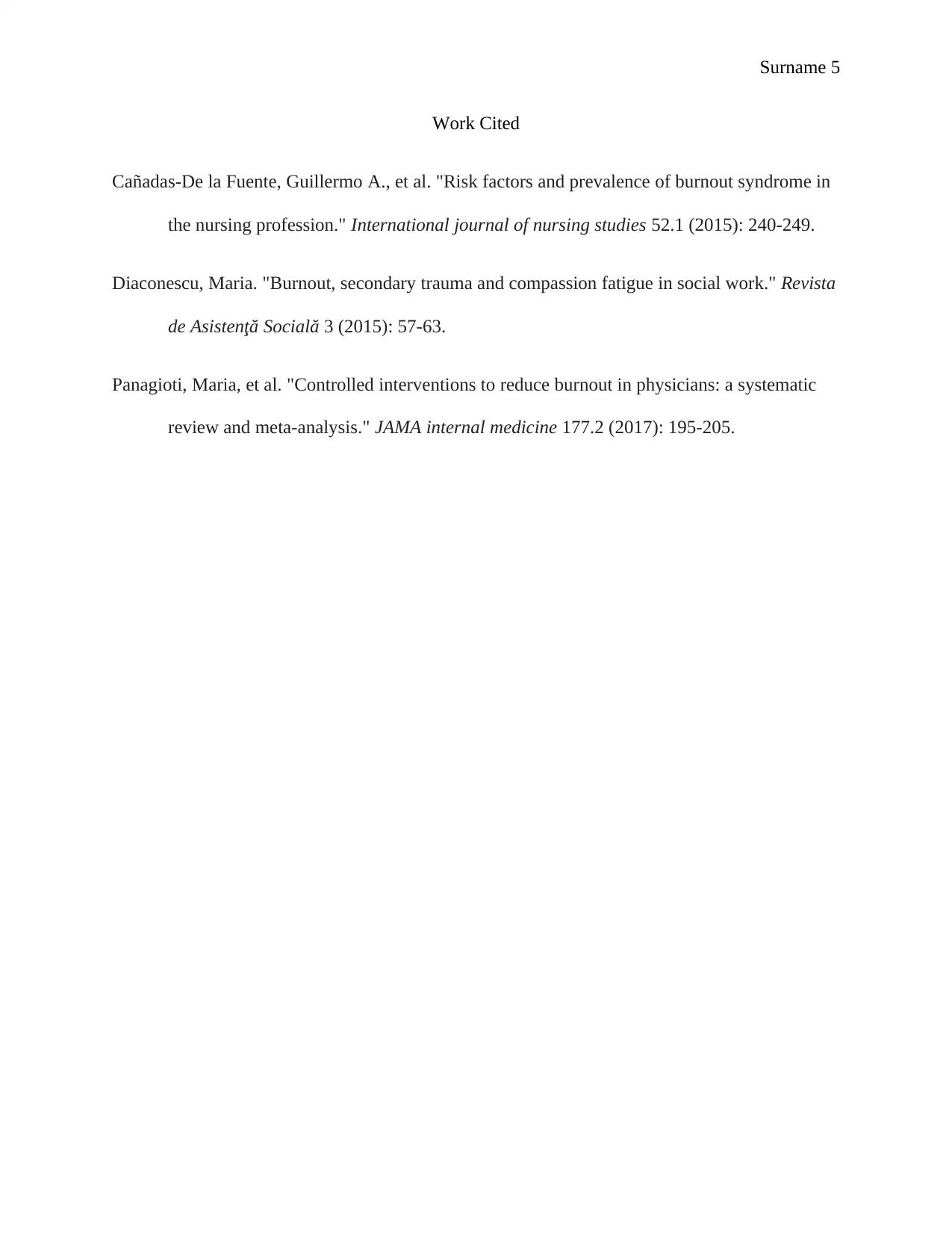Burnout in Human Services: Dynamics, Relationships, and Interventions
VerifiedAdded on 2022/07/28
|5
|1031
|267
Essay
AI Summary
This essay provides a comprehensive analysis of burnout within the human services field. It begins by defining burnout, discussing its dynamics, including research, symptoms, stages, and levels, referencing the Maslach Burnout Inventory. The essay then examines worker-client relationships, delving into countertransference, secondary traumatic stress, vicarious traumatization, compassion, and fatigue. Finally, it explores various intervention strategies for burnout, differentiating between individual-level approaches like cognitive-behavioral therapy and organizational-level interventions such as modifying work practices and culture. The essay emphasizes the importance of addressing burnout to improve worker well-being and enhance the quality of service delivery, supported by academic research and literature.

Surname 1
Student’s Name
Professor
Subject
Date
A.) Discuss the dynamics of burnout, include research regarding burnout, symptoms, levels, and
stages.
Every person experiences demanding working days which is dependent on the type of
clients, resultant stresses, environments, as well as working conditions. Burnout is defined as a
state where an individual experiences emotional exhaustion. Through research and literature, the
causes, symptoms, stages, levels, elements, as well as the impacts of burnout syndrome have
been identified. In the seventies, burnout was classified as a professional disease. Among the
first researchers in the dynamism of burnout was Christina Maslach (1986) who developed the
Maslach Burnout Inventory. Christina defined burnout as a syndrome resulting from emotional
exhaustion, reduced individual accomplishment, along with depersonalization. In her research,
Christina identified job characteristics that can result in burnout, including experienced overload
or subjective stress. The symptoms for burnout comprise of both physical and emotional
symptoms. Physical symptoms include changes in appetite as well as a change in sleep habits,
frequent headaches, frequent illness, and feeling tired most of the time. Emotional symptoms
include loss of motivation, detachment, and decreased satisfaction, feeling helpless and defeated,
along with having a negative outlook (Cañadas-De la Fuente et al. 244). Commonly observed
Student’s Name
Professor
Subject
Date
A.) Discuss the dynamics of burnout, include research regarding burnout, symptoms, levels, and
stages.
Every person experiences demanding working days which is dependent on the type of
clients, resultant stresses, environments, as well as working conditions. Burnout is defined as a
state where an individual experiences emotional exhaustion. Through research and literature, the
causes, symptoms, stages, levels, elements, as well as the impacts of burnout syndrome have
been identified. In the seventies, burnout was classified as a professional disease. Among the
first researchers in the dynamism of burnout was Christina Maslach (1986) who developed the
Maslach Burnout Inventory. Christina defined burnout as a syndrome resulting from emotional
exhaustion, reduced individual accomplishment, along with depersonalization. In her research,
Christina identified job characteristics that can result in burnout, including experienced overload
or subjective stress. The symptoms for burnout comprise of both physical and emotional
symptoms. Physical symptoms include changes in appetite as well as a change in sleep habits,
frequent headaches, frequent illness, and feeling tired most of the time. Emotional symptoms
include loss of motivation, detachment, and decreased satisfaction, feeling helpless and defeated,
along with having a negative outlook (Cañadas-De la Fuente et al. 244). Commonly observed
Paraphrase This Document
Need a fresh take? Get an instant paraphrase of this document with our AI Paraphraser

Surname 2
stages include the stress arousal stage that comprises of psychological and physiological
responses. The other stage is energy conservation that aims at compensating for stress. The last
stage is exhaustion in which, an individual begins to feel that something is wrong. Maslach
Burnout Inventory identifies emotional exhaustion, reduced performance accomplishment, and
depersonalization as some of the levels of burnout.
B.) What about worker-client relationships? Discuss countertransference, secondary traumatic
stress, vicarious traumatization, compassion, and fatigue.
The relationship between a worker and a client are central to achieving positive treatment
outcomes. The worker-client relationship refers to the association, connection, as well as rapport
between a worker and the client. Establishing the relationship starts with a joining process in
which, the client and the worker get to know each other. The relationship entails engaging the
client in a collaborative manner and placing the client’s needs first among others.
Countertransference is an occurring scenario in a counseling relationship representing the
manner in which a client feels or acts towards his/her therapist, or the other way round. Besides,
secondary traumatic stress refers to the emotional duress that results when a person becomes
aware of the firsthand trauma experienced by others. Secondary traumatic stress results from
working with traumatized clients (Diaconescu and Maria 59). Vicarious traumatization, on the
other hand, is a negative transformation among workers that results from emphatically engaging
with trauma survivors along with their traumatic material, including their responsibility to such
individuals. Compassion and fatigue results from assisting or wanting to assist traumatized
individuals or those people facing a significant level of emotional duress. Compassion fatigue is
stages include the stress arousal stage that comprises of psychological and physiological
responses. The other stage is energy conservation that aims at compensating for stress. The last
stage is exhaustion in which, an individual begins to feel that something is wrong. Maslach
Burnout Inventory identifies emotional exhaustion, reduced performance accomplishment, and
depersonalization as some of the levels of burnout.
B.) What about worker-client relationships? Discuss countertransference, secondary traumatic
stress, vicarious traumatization, compassion, and fatigue.
The relationship between a worker and a client are central to achieving positive treatment
outcomes. The worker-client relationship refers to the association, connection, as well as rapport
between a worker and the client. Establishing the relationship starts with a joining process in
which, the client and the worker get to know each other. The relationship entails engaging the
client in a collaborative manner and placing the client’s needs first among others.
Countertransference is an occurring scenario in a counseling relationship representing the
manner in which a client feels or acts towards his/her therapist, or the other way round. Besides,
secondary traumatic stress refers to the emotional duress that results when a person becomes
aware of the firsthand trauma experienced by others. Secondary traumatic stress results from
working with traumatized clients (Diaconescu and Maria 59). Vicarious traumatization, on the
other hand, is a negative transformation among workers that results from emphatically engaging
with trauma survivors along with their traumatic material, including their responsibility to such
individuals. Compassion and fatigue results from assisting or wanting to assist traumatized
individuals or those people facing a significant level of emotional duress. Compassion fatigue is

Surname 3
less predictable but can be treated, which is not the case with burnout. Whereas burnout over a
given time, the emergence of compassion fatigue is sudden.
C.) What are some intervention strategies involved in burnout?
Interventions that are designed to reduce burnout symptoms, - effects and risks associated
with burnout and work-related stress are observed to operate efficiently at the individual level
rather than a structural level. Little evidence exists to show that individually directed
interventions can minimize work-related stress and burnout. Most discussions pertaining to
burnout intervention address individual-based solutions. Such interventions are effective in
alleviating a person’s exhaustion. However, research has revealed that these interventions are
relatively ineffective in instances where the workplace does not provide the staff with enough
control over stressors compared to other domains of their lives. Other intervention strategies
include person-directed programs. For instance, staff training, as well as workshops, are effective
intervention strategies for preventing burnout symptoms. This may comprise stress awareness
courses that focus on coping. When these interventions are supported by a philosophy of staff
participation along with providing a safe and non-threatening environment, there is an enhanced
chance of positive outcomes. Cognitive-behavioral therapy is the other individual-level
intervention. This type of intervention has proven more effective compared to other workplace
interventions such as mediation techniques and relaxation (Panagioti et al.201). Besides,
mindfulness-based interventions that emphasize conscious awareness have proven effective in
minimizing the psychological effects associated with the working environment. However, little
evidence exists to show that this type of intervention is more effective compared to other stress
less predictable but can be treated, which is not the case with burnout. Whereas burnout over a
given time, the emergence of compassion fatigue is sudden.
C.) What are some intervention strategies involved in burnout?
Interventions that are designed to reduce burnout symptoms, - effects and risks associated
with burnout and work-related stress are observed to operate efficiently at the individual level
rather than a structural level. Little evidence exists to show that individually directed
interventions can minimize work-related stress and burnout. Most discussions pertaining to
burnout intervention address individual-based solutions. Such interventions are effective in
alleviating a person’s exhaustion. However, research has revealed that these interventions are
relatively ineffective in instances where the workplace does not provide the staff with enough
control over stressors compared to other domains of their lives. Other intervention strategies
include person-directed programs. For instance, staff training, as well as workshops, are effective
intervention strategies for preventing burnout symptoms. This may comprise stress awareness
courses that focus on coping. When these interventions are supported by a philosophy of staff
participation along with providing a safe and non-threatening environment, there is an enhanced
chance of positive outcomes. Cognitive-behavioral therapy is the other individual-level
intervention. This type of intervention has proven more effective compared to other workplace
interventions such as mediation techniques and relaxation (Panagioti et al.201). Besides,
mindfulness-based interventions that emphasize conscious awareness have proven effective in
minimizing the psychological effects associated with the working environment. However, little
evidence exists to show that this type of intervention is more effective compared to other stress
⊘ This is a preview!⊘
Do you want full access?
Subscribe today to unlock all pages.

Trusted by 1+ million students worldwide

Surname 4
management methods that include yoga and relaxation. Nonetheless, there are organizational-
level interventions. The organizational level intention strategies are observed to produce a
longer-lasting outcome as compared to the individual-oriented strategies. Modifying an
organization’s culture as well as the working practices in addition to the individual level
intervention can help attain a stronger impact in relation to burnout prevention. Making
alterations such as workload or changing working practices are some of the organizational level
interventions that can help reduce stressors as well as factors that can result in burnout.
management methods that include yoga and relaxation. Nonetheless, there are organizational-
level interventions. The organizational level intention strategies are observed to produce a
longer-lasting outcome as compared to the individual-oriented strategies. Modifying an
organization’s culture as well as the working practices in addition to the individual level
intervention can help attain a stronger impact in relation to burnout prevention. Making
alterations such as workload or changing working practices are some of the organizational level
interventions that can help reduce stressors as well as factors that can result in burnout.
Paraphrase This Document
Need a fresh take? Get an instant paraphrase of this document with our AI Paraphraser

Surname 5
Work Cited
Cañadas-De la Fuente, Guillermo A., et al. "Risk factors and prevalence of burnout syndrome in
the nursing profession." International journal of nursing studies 52.1 (2015): 240-249.
Diaconescu, Maria. "Burnout, secondary trauma and compassion fatigue in social work." Revista
de Asistenţă Socială 3 (2015): 57-63.
Panagioti, Maria, et al. "Controlled interventions to reduce burnout in physicians: a systematic
review and meta-analysis." JAMA internal medicine 177.2 (2017): 195-205.
Work Cited
Cañadas-De la Fuente, Guillermo A., et al. "Risk factors and prevalence of burnout syndrome in
the nursing profession." International journal of nursing studies 52.1 (2015): 240-249.
Diaconescu, Maria. "Burnout, secondary trauma and compassion fatigue in social work." Revista
de Asistenţă Socială 3 (2015): 57-63.
Panagioti, Maria, et al. "Controlled interventions to reduce burnout in physicians: a systematic
review and meta-analysis." JAMA internal medicine 177.2 (2017): 195-205.
1 out of 5
Related Documents
Your All-in-One AI-Powered Toolkit for Academic Success.
+13062052269
info@desklib.com
Available 24*7 on WhatsApp / Email
![[object Object]](/_next/static/media/star-bottom.7253800d.svg)
Unlock your academic potential
Copyright © 2020–2025 A2Z Services. All Rights Reserved. Developed and managed by ZUCOL.





